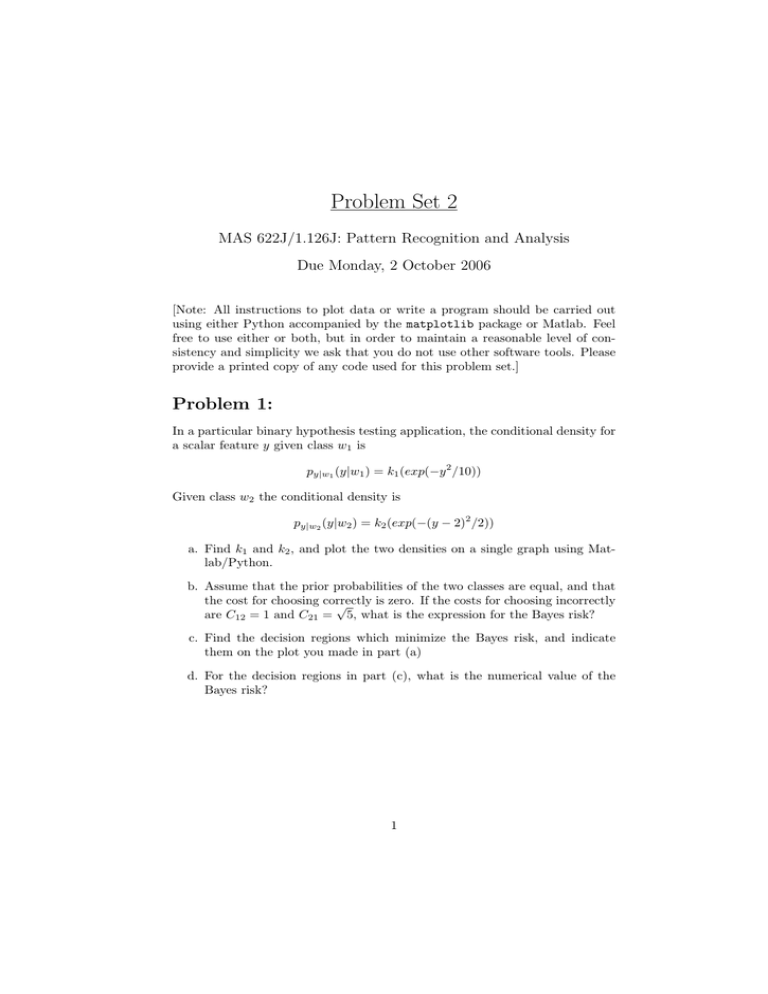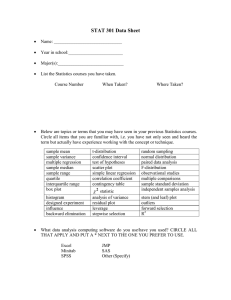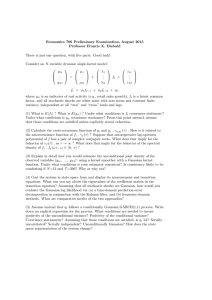Problem Set 2 MAS 622J/1.126J: Pattern Recognition and Analysis
advertisement

Problem Set 2
MAS 622J/1.126J: Pattern Recognition and Analysis
Due Monday, 2 October 2006
[Note: All instructions to plot data or write a program should be carried out
using either Python accompanied by the matplotlib package or Matlab. Feel
free to use either or both, but in order to maintain a reasonable level of con­
sistency and simplicity we ask that you do not use other software tools. Please
provide a printed copy of any code used for this problem set.]
Problem 1:
In a particular binary hypothesis testing application, the conditional density for
a scalar feature y given class w1 is
py|w1 (y|w1 ) = k1 (exp(−y 2 /10))
Given class w2 the conditional density is
py|w2 (y|w2 ) = k2 (exp(−(y − 2)2 /2))
a. Find k1 and k2 , and plot the two densities on a single graph using Matlab/Python.
b. Assume that the prior probabilities of the two classes are equal, and that
the cost for choosing correctly
is zero. If the costs for choosing incorrectly
√
are C12 = 1 and C21 = 5, what is the expression for the Bayes risk?
c. Find the decision regions which minimize the Bayes risk, and indicate
them on the plot you made in part (a)
d. For the decision regions in part (c), what is the numerical value of the
Bayes risk?
1
Problem 2:
[Note: Use Matlab or Python for the computations, but make sure to explicitly
construct every transformation required, that is either type it or write it. Do
not use Matlab or Python if you are asked to explain/show something.]
Consider the three-dimensional normal distribution p(x|w) with mean µ and
covariance matrix Σ where
⎛ ⎞
⎛
⎞
1
1 0 0
µ = ⎝ 2 ⎠,Σ = ⎝ 0 6 3 ⎠.
3
0 3 6
Compute the matrices representing the eigenvectors and eigenvalues Φ and
Λ to answer the following:
a. Find the probability density at the point x0 = (.75 0 1)T
b. Construct an orthonormal transformation y = ΦT x. Show that for or­
thonormal transformations, Euclidean distances are preserved (i.e., �y�2 =
�x�2 ).
c. After applying the orthonormal transformation add another transforma­
tion Λ−1/2 and convert the distribution to one centered on the origin with
covariance matrix equal to the identity matrix. Show that Aw = ΦΛ−1/2
is a linear transformation (i.e., Aw (ax + by) = aAw x + bAw y)
d. Apply the same overall transformation to x0 to yield a transformed point
xw
e. Calculate the Mahalanobis distance from x0 to the mean µ and from xw
to 0. Are they different or are they the same? Why?
f. Does the probability density remain unchanged under a general linear
transformation? In other words, is p(x0 |µ, Σ) = p(ZT x0 |ZT µ, ZT ΣZ)
for some linear transform Z? Explain.
2
Problem 3:
Let x be an observation vector. You would like to determine whether x belongs
to w1 or w2 based on the following decision rule, namely decision rule 1.
Decide w1 if − ln p(x|w1 ) + ln p(x|w2 ) < ln{P(w1 )/P(w2 )}; other­
wise decide w2 .
You know that this rule does not lead to perfect classification therefore you
must calculate the probability of error. Let χ1 and χ2 be the region in the
domain of x such that
p(x|w1 )P(w1 ) > p(x|w2 )P(w2 ) and p(x|w1 )P(w1 ) < p(x|w2 )P(w2 ),
respectively.
Then if x ∈ χi , for i = 1, 2 assign the sample to class wi . Use excruciating
detail to answer the following:
a. Show that the Pr[error] for this rule is given by:
Pr[error] = P(w1 )�1 + P(w2 )�2
�
�
where �1 =
p(x|w1 )dx and �2 =
p(x|w2 )dx
χ2
χ1
b. Describe what the previous equation says about the total error. (hint:
identify what �1 and �2 mean)
c. Suppose that for a given decision, you must pay a cost depending on the
true class of the sample based on decision rule 1. Assume that a wrong
decision is more expensive than a correct one, where λij = λ(deciding
wi |wj ) is the loss incurrred for desiding wi when the state of nature is wj .
Write an expression for the expected cost, namely risk, R, such that
E[cost] = E[fixed costs] + E[variable costs]
(hint: recall that the decision rule induces a partitioning of the measure­
ment space into a number of disjoint regions)
d. Suppose that for a given value of x, the integrand in the risk function is
positive. How can you decrease the risk? (hint: think about where you
would assign x to and why you would make that decision)
e. Show that for a symmetrical cost function λ12 −λ22 = λ21 −λ11 , E[cost] =
Pr[error].
3
Problem 4:
Use signal detection theory as well as the notation and basic Gaussian assump­
tions described in the text to address the following
a. Prove that P(x > x∗ |x ∈ w2 ) and P(x > x∗ |x ∈ w1 ), taken together,
uniquely determine the discriminability d�
b. Use error functions erf (∗) to express d� in terms of the hit and false alarm
rates. Estimate d� if P(x > x∗ |x ∈ w1 ) = .6 and P(x > x∗ |x ∈ w2 ) = .5.
Repeat for d� if P(x > x∗ |x ∈ w1 ) = .9 and P(x > x∗ |x ∈ w2 ) = .2.
c. Given that the Gaussian assumption is valid, calculate the Bayes error for
both the cases in (b).
d. Using a trivial one-line computation or a graph determine which case has
the higher d� , and explain your logic:
Case A: P(x > x∗ |x ∈ w1 ) = .7 and P(x > x∗ |x ∈ w2 ) = .4.
Case B: P(x > x∗ |x ∈ w1 ) = .2 and P(x > x∗ |x ∈ w2 ) = .8.
Problem 5:
a. Show that the maximum likelihood (ML) estimation of the mean for a
Gaussian is unbiased but the ML estimate of variance is biased (i.e.,
slightly wrong). Show how to correct this variance estimate so that it
is unbiased.
b. For this part you’ll write a program with Matlab/Python to explore the
biased and unbiased ML estimations of variance for a Gaussian distribu­
tion. Find the data for this problem on the class webpage as ps2.dat. This
file contains n=5000 samples from a 1-dimensional Gaussian distribution.
(a) Write a program to calculate the ML estimate of the mean, and
report the output.
(b) Write a program to calculate both the biased and unbiased ML esti­
mate of the variance of this distribution. For n=1 to 5000, plot the
biased and unbiased estimates of the variance of this Gaussian. This
is as if you are being given these samples sequentially, and each time
you get a new sample you are asked to re-evaluate your estimate of
the variance. Give some interpretation of your plot.
Problem 6:
DHS 3.7
4






